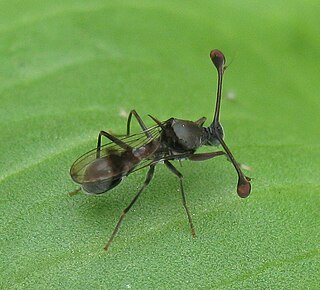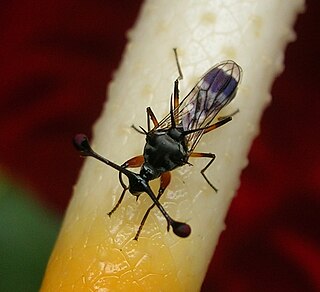
Stalk-eyed flies are insects of the fly family Diopsidae. The family is distinguished from most other flies by most members of the family possessing "eyestalks": projections from the sides of the head with the eyes at the end. Some fly species from other families such as Drosophilidae, Platystomatidae, Richardiidae, and Tephritidae have similar heads, but the unique character of the Diopsidae is that their antennae are located on the stalk, rather than in the middle of the head as in all other flies. Stalked eyes are present in all members of the subfamily Diopsinae, but are absent in the Centrioncinae, which retain unstalked eyes similar to those of other flies. The stalked eyes are usually sexually dimorphic, with eyestalks present but shorter in females.

The Platystomatidae are a distinctive family of flies (Diptera) in the superfamily Tephritoidea.

Siphunculina is a genus of small flies known as tropical eye flies. They are known for their habit of visiting the eyes of humans and other vertebrates to feed on fluids and in doing so cause annoyance, spread bacterial or viral diseases or cause injury to the eye. They have a habit of resting in large numbers on suspended strings, ropes and cobwebs.

Diasemopsis is a genus of stalk-eyed flies in the family Diopsidae. They are known from sub-Saharan Africa.

Sphyracephala is a genus of stalk-eyed flies in the family Diopsidae, with records from Africa, Europe, Asia and N. America.
Prosphyracephala is a genus of flies in the family Diopsidae. The genus is presumed to be extinct, and is known from specimens in Baltic amber. Among extant taxa, Prosphyracephala most closely resembles the genus Sphyracephala. It was originally described as a species of the latter genus, but was recognized as distinct by Willi Hennig in 1965.

Teleopsis is a genus of stalk-eyed flies in the family Diopsidae. All species in the genus are found in Asia. About 20 species are described and several others as yet are to be described.
Eosiopsis is a genus of Asian stalk-eyed flies in the family Diopsidae.
Centrioncus is a genus of African stalk-eyed flies in the family Diopsidae.
Cyrtodiopsis is a genus of South-east Asian stalk-eyed flies in the subfamily Diopsinae.
Diopsina is a genus of stalk-eyed flies in the family Diopsidae.
Centrioncinae is a subfamily of stalk-eyed flies in the family Diopsidae.
Teloglabrus is a genus of African stalk-eyed flies in the family Diopsidae.
Pseudodiopsis is a genus of stalk-eyed flies in the family Diopsidae.
Eurydiopsis is a genus of stalk-eyed flies in the family Diopsidae. from Malesia'

Richardia is a genus of flies in the family Richardiidae. It was first described by French entomologist Jean-Baptiste Robineau-Desvoid in 1830. It occurs from Mexico to Central and South America.

Sphyracephala brevicornis is a species in the family Diopsidae, in the order Diptera ("flies"). A common name for Sphyracephala brevicornis is "short-horned ankle-headed fly".

Teleopsis dalmanni, synonym Cyrtodiopsis dalmanni, also known as the Malaysian stalk-eyed fly, is a species of fly in the family Diopsidae. T. dalmanni flies possess lateral elongations on their head capsules called eyestalks. These eyestalks play an important role in mate selection and as a result physical characteristic of the fly has been the subject of several studies on sexual selection, natural selection, and mating behavior.

Teleopsis amnoni is a species of stalk-eyed fly found in the Western Ghats of India. The species was described by Feijen & Feijen in 2019 and said to be closely related to Teleopsis sykesii from which it can be distinguished by the clear tip to the wing apart from other characters. The species is known from India, in the states of Karnataka, Kerala and Maharashtra.










